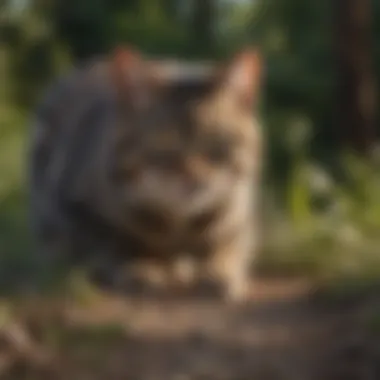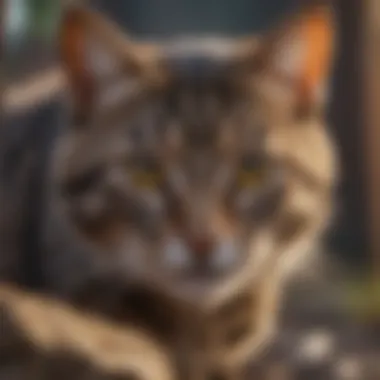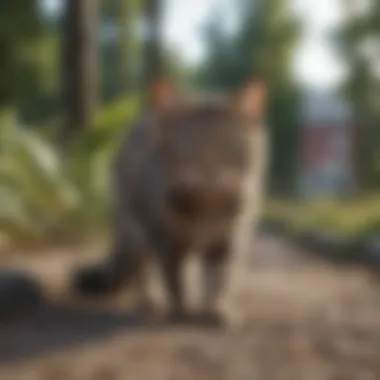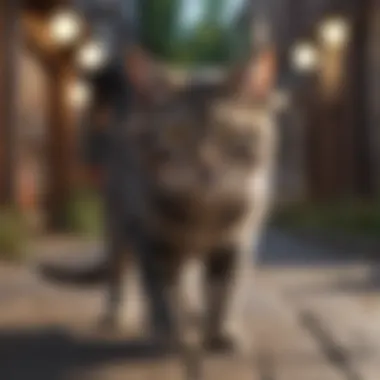Understanding What Repels Feral Cats: A Comprehensive Analysis


Intro
Feral cats, often seen as pests, possess a complex set of behaviors and traits that are crucial to understanding how to effectively repel them. Knowing how they interact with their surroundings can lead to better strategies for deterring these animals, taking into account both human intervention and animal welfare. By delving into the elements that repel feral cats, such as scents, sounds, and barriers, we aim to provide a comprehensive understanding that benefits communities and the feral cat population alike.
Fascinating Facts About the Animal
Feral cats are not a simple collection of strays; they exhibit a variety of unique characteristics that set them apart from domesticated cats. Understanding these traits is essential to implementing successful repellent methods.
Unique Characteristics
One significant aspect of feral cats is their adaptability. They have learned to survive in a range of environments from urban landscapes to rural fields. Their instincts play a vital role in foraging for food and finding shelter. Unlike domesticated cats, feral cats often live solitary lives or form loose colonies, relying heavily on their environmental awareness.
Extraordinary Abilities
Feral cats display remarkable hunting skills. Their keen senses allow them to locate prey even in challenging conditions. Their agility enables them to climb and jump, making them difficult to catch. Some feral cats have even been observed working cooperatively to hunt, showcasing a level of social interaction that surprises many people.
Behavior and Habitat
To effectively repel feral cats, it is vital to understand their behavior and natural habitat. This knowledge allows for targeted strategies that align with their instincts.
Natural Habitats
Feral cats typically prefer environments where they can easily hide. They thrive in urban areas with plenty of alleys and garbage bins. Similarly, rural settings with dense foliage and abandoned buildings offer ideal conditions. The more secluded an area, the more likely it is to be a feral cat's territory.
Social Structures
Feral cat colonies can sometimes consist of familial ties, although these are generally loose. They communicate through vocalizations, scent markings, and body language. Understanding these social structures can help communities devise humane methods for population control and management.
Recent Scientific Discoveries
Recent advances in research have shed light on the biology and behavior of feral cats. Keeping up with these discoveries is essential for effective management strategies.
Latest Research Findings
Studies indicated that feral cats have a significant impact on local wildlife populations. This underscores the need for humane interventions that address both feral cat management and wildlife conservation.
Breakthroughs in Animal Biology
New findings related to cat biology have revealed biological barriers that discourage egress from certain environments. Understanding these barriers can enhance feral cat repellent strategies, leading to more humane solutions.
Cultural Significance
Feral cats hold a place in folklore and culture, adding depth to their understanding beyond just their behavior.
Animals in Folklore
Culturally, cats are often associated with mystery and independence. In various cultures, they play roles that depict them as companions in various myths and stories.
Influence on Art and Literature
Feral cats, particularly in urban settings, have attracted attention in art and literature, capturing the imagination of many. Their resilience mirrors broader themes of survival in artistic expressions.
The intricate relationship between feral cats and their environments can lead to innovative solutions for humane management.
By synthesizing the information presented in this analysis, we can develop effective, humane strategies that address the presence of feral cats in our communities.
Intro to Feral Cats
Feral cats represent a significant challenge in the realm of animal behavior and ecology. Addressing their presence requires a nuanced understanding of their needs, habits, and the environment in which they thrive. This section will provide a foundational understanding of what defines feral cats and why delving into their behavior is crucial.
Defining Feral Cats
Feral cats are domestic cats that have reverted to a wild state. Unlike house pets, they are typically unsocialized and avoid interaction with humans. This transformation can occur through various means, such as abandonment or insufficient human socialization from a young age. The distinction between feral and domestic cats is paramount; stray cats—generally lost or abandoned pets—may still seek human interaction.
Feral cats generally live in colonies, which can form around sustainable food sources. Their behaviors are heavily influenced by their environment, and their adaptability allows them to thrive in various settings, from urban to rural. Understanding these definitions is essential as it lays the groundwork for proper management and treatment strategies that consider their wild instincts and social structures.
The Importance of Studying Their Behavior
Studying the behavior of feral cats is vital for several reasons. First, it informs humane management practices. Recognizing how feral cats interact with their ecosystems aids in designing interventions that minimize their impact on local wildlife. For example, Targeted Trap-Neuter-Return (TNR) initiatives can effectively reduce feral cat populations over time in human-centered areas while respecting their natural instincts.
Second, understanding feral cat behavior allows communities to implement appropriate deterrents. Residents often seek solutions to reduce the disturbances caused by feral cats, which may include noise and territorial marking. By grasping what attracts or repels feral cats, individuals can make informed choices about the methods to employ without resorting to inhumane tactics.
Finally, knowledge about their behavior strengthens conservation efforts. By recognizing the ecological roles feral cats play, methods can be developed to balance their existence with the protection of native species. It emphasizes the necessity of coexistence rather than eradication, fostering a more comprehensive approach to wildlife management.


Understanding feral cats extends beyond mere nuisance management; it encourages a more humane approach that respects their nature while seeking solutions.
Common Misconceptions About Feral Cats
Understanding common misconceptions about feral cats is crucial for creating effective management strategies and enhancing public awareness. Many individuals view feral cats simply as nuisances or threats to wildlife without grasping their complex nature. Such misconceptions can lead to ineffective or even cruel methods of dealing with their presence. This section aims to dismantle these misunderstandings while fostering a more informed approach to feral cat interactions.
Feral vs.
Domestic Cats
Feral cats differ significantly from domestic cats in terms of behavior and socialization. Domestic cats, bred for companionship, typically exhibit friendly or approachable traits. In contrast, feral cats tend to avoid human interaction, having had little to no positive exposure to humans.
- Socialization: Domestic cats often seek human contact, while feral cats may evade it altogether, viewing humans as threats. This leads to their behavior being more skittish in nature.
- Habitat: Domestic cats live primarily within human homes, while feral cats find shelter outdoors, often adapting to various environments such as alleys, parks, and neighborhoods.
- Reproduction: In many cases, feral cats reproduce at a higher rate than domestic cats, which can lead to overpopulation issues in areas where they thrive.
Misperceptions about these differences can lead to misplaced solutions. For instance, attempts to socialize feral cats often fail, and these animals can end up stressed or injured.
The Impact of Feral Cats on Ecosystems
Feral cats are frequently cited as harmful to local ecosystems, particularly concerning wildlife populations. However, the ecological impacts of these animals are nuanced and require careful consideration.
- Predation: While feral cats do hunt wildlife, they are not the sole predator impacting local fauna. Birds, rodents, and other small animals face threats from multiple sources, including habitat loss and urban development.
- Population Control: The balance of ecosystems can be disrupted by feral cat populations, but they can also be part of a natural food web. Their presence may instigate a balance, wherein their predatory behavior informs prey population dynamics.
Research indicates that managing feral cat populations should focus on humane strategies like Trap-Neuter-Return (TNR), which aims to control numbers without resorting to euthanasia. These acts can mitigate ecological damage while promoting healthier community interactions with feral cat populations.
Sensory Perception of Feral Cats
Understanding the sensory perception of feral cats provides crucial insight into their behaviors and interactions within their environment. This knowledge is important for developing effective deterrents, which can help manage feral cat populations humanely. Cats possess a sophisticated set of sensory tools that enable them to navigate their surroundings, hunt, and communicate. Examining how feral cats use their senses to perceive threats or food can guide us in creating environments that repel them. Recognizing these sensory cues can also foster better community awareness about how to mitigate feral cat issues.
The Role of Smell in Deterrence
Smell plays a significant role in the life of feral cats. Their olfactory system is highly developed, making them sensitive to various scents. Feral cats can detect pheromones from other animals, which helps them identify territory and potential threats. Certain scents can trigger avoidance behavior, offering a practical method for deterring them. For example, strong smells such as citronella, vinegar, and citrus are often reported to repel feral cats effectively. Here are some points to consider regarding the role of smell:
- Scent sensitivity: Feral cats have a keen sense of smell that can detect odors in minute concentrations.
- Territorial marking: Cats often use scent to mark their territory. Therefore, introducing unfamiliar scents might cause them to steer clear of specific areas.
- Practical applications: Using scent-based repellents can be an inexpensive and accessible method for those looking to deter feral cats from their properties.
Auditory Factors That Repel Feral Cats
Sound also serves as an essential sensory input for feral cats. Their hearing is finely tuned, allowing them to detect a wide range of frequencies, including those that humans cannot hear. Because of this sensitivity, certain sounds may deter feral cats effectively. Noise can evoke a flight response in feral cats, making them more likely to vacate an area if they perceive it as unsafe. Here are important auditory factors to consider:
- Ultrasonic devices: These devices produce sounds at frequencies above human hearing, causing discomfort for cats without affecting nearby humans.
- Predator calls: The sounds of animals like wolves or coyotes may trigger an instinctive fear response, prompting feral cats to move away from the source.
- Loud, sudden noises: Clapping, banging, or other abrupt sounds can startle feral cats and encourage them to leave quickly.
Visual Deterrents: What Works?
Visual stimuli also impact feral cat behavior. The way they perceive their surroundings is influenced by what they see, which can be utilized for deterrent strategies. Understanding its significance can lead to the development of effective methods for discouraging their presence in certain zones. Some visual deterrents that can work include:
- Reflective materials: Items that reflect light, such as aluminum foil or reflective tape, can create an environment that cats find unsettling.
- Scarecrow innovations: Moving objects or figures that mimic predators can serve as a psychological mouthful for feral cats, keeping them at a distance.
- Scary images: Banners or large visuals depicting potential threats may encourage feral cats to avoid an area altogether.
In essence, comprehending the sensory perception of feral cats illuminates avenues for effective deterrence strategies. By utilizing their acute senses of smell, hearing, and sight, communities can adopt humane, practical solutions to manage feral cat interactions positively.
Scent-Based Repellents
Scent-based repellents play a vital role in managing feral cat populations and mitigating their impacts on both ecology and human environments. Understanding how different scents affect feral cats' behavior allows us to develop effective strategies. Other repellents can protect areas where feral cats may cause disruption. The efficacy of scent repellents can vary based on individual cat preferences and experiences, but using commonly known scents can guide the process.
Common Scents That Deter Feral Cats
Citronella
Citronella is well-known for being an effective deterrent against various animals. Its strong citrus smell acts as a signal that many cats find unpleasant. This scent's distinctiveness makes it useful in preventing feral cats from entering certain spaces. Moreover, citronella is often regarded as a safe choice for both humans and pets. The ability to naturally repel feral cats without chemicals is a significant benefit. However, its effectiveness may diminish after being exposed to weather elements, thus requiring frequent reapplication.
Vinegar
Vinegar is another effective option when it comes to repelling feral cats. Its strong, pungent smell can deter cats from marked areas. Many people appreciate vinegar for its accessibility and low cost, making it a practical choice for homeowners. It works well in repelling feral cats but can also have less desirable effects, like leaving a lingering odor for humans. This can be seen as a disadvantage, especially for those sensitive to strong smells. Thus, careful application is needed to avoid overwhelming scents in living areas.
Citrus Scents
Citrus scents, particularly lemon and orange, have proven to be powerful deterrents for cats. Cats typically dislike these smells, and they can be used in various forms, such as essential oils or peels. The refreshing aroma of citrus not only repels cats but can also leave behind a pleasant scent for humans. Being easy to find, these scents provide a widely appealing option for those looking to deter feral cats. However, care should be taken as some citrus solutions may not be suitable for all environments.
Commercial Cat Repellents
Commercial cat repellents are specifically formulated products designed to deter felines from specific areas. Many of these products utilize a combination of scents, sounds, or visual cues to reduce feline presence. These repellents can vary in effectiveness, often depending on the individual sensitivities of cats. Some products contain natural ingredients, which appeal to individuals looking for humane options. However, it is important to read labels and ensure the selected product does not contain harmful chemicals.
These commercial options can offer added convenience since they are pre-mixed and easy to apply. Nevertheless, it's crucial to remain aware of the potential costs involved and the need for occasional reapplication. Additionally, personal experiences can help guide which products work most effectively in different situations.
Use of Sound as a Deterrent
Sound can be a powerful tool in the effort to repel feral cats. Understanding how cats perceive sound is crucial for implementing effective deterrents. Feral cats have sensitive hearing and can detect sounds at frequencies higher than humans can. Therefore, using sound as a deterrent taps into their natural instincts and sensory abilities, making it an effective method.


There are various types of sound deterrents available today, ranging from ultrasonic devices to recordings of predator calls. Each has its benefits and considerations. While sound-based deterrents can be humane and non-invasive, their effectiveness can vary. Some cats may become accustomed to the sounds, reducing their impact over time.
Ultrasonic Devices
Ultrasonic devices have gained popularity as a means to deter feral cats. These devices emit high-frequency sounds that are unpleasant to cats but inaudible to most humans. The primary advantage of using ultrasonic devices is their ability to create an environment that is unfriendly to feral cats without any harm.
In terms of installation, these devices are typically easy to set up. They work best in areas where feral cats are known to frequent. The sounds produced can range between 20 kHz and 65 kHz. However, the effectiveness can depend on placement and the density of the surrounding environment. It's essential to position these devices where the sound can travel unobstructed.
"Ultrasonic deterrents rely on the principle that discomfort from sound can keep feral cats away from specific areas."
Benefits of Ultrasonic Devices:
- Non-invasive approach: These devices do not cause physical harm to cats.
- Easy installation: Most models can be set up without professional assistance.
- Continuous deterrent: Many devices operate continually or at intervals, creating an ongoing deterrent effect.
Considerations:
- Acclimation: Cats may learn to ignore continuous sounds over time.
- Environmental barriers: Walls and landscaping can absorb or deflect sound, reducing effectiveness.
Predator Sounds
Using predator sounds is another effective method to deter feral cats. These sounds can mimic common predators of domestic cats, creating a perception of danger in the environment. Examples include calls from dogs, owls, or larger wild cats.
Predator sounds work on instinct; many animals have an innate fear of their predators. By playing these sounds in areas where feral cats roam, you can leverage this fear to discourage their presence. Specific recordings can include territorial calls or distress sounds from potential prey. This method may be particularly useful in conjunction with other deterrents.
Benefits of Using Predator Sounds:
- Effective instinctual response: Cats naturally avoid areas where they perceive threats.
- Variety of sounds: A range of predator sounds can be broadcasted, keeping the environment dynamic and unpredictable for feral cats.
Considerations:
- Sound frequency and volume: These need to be adjusted based on the local environment to avoid overwhelming nearby residents or other wildlife.
- Temporary effect: Cats may return once the threat level is perceived to be low.
Visual Deterrents for Feral Cats
Visual deterrents play a crucial role in managing feral cat populations and minimizing their impact on communities. These methods focus on utilizing visuals to change the behavior and movement of feral cats in a specific area. The significance of this topic extends beyond just keeping feral cats at bay; it involves understanding their instincts and how they perceive the world around them. As feral cats rely heavily on their visual senses for navigation, creating an environment that visually deters them can be effective.
Reflective Materials
Reflective materials serve as a vital tool in deterring feral cats. When sunlight hits reflective surfaces, it creates bright flashes of light that can startle cats and make an area feel unsafe. This response is due to feral cats’ natural aversion to sudden movements and unexpected stimuli.
The effectiveness of reflective materials also stems from their low cost and easy installation. Items like old CDs, aluminum foil strips, or reflective tape can be set up in gardens or areas where feral cats linger. Their key characteristic is that they are non-invasive and do not harm the animals while disrupting their environment.
Advantages of Reflective Materials
- Cost-effective: Many reflective materials can be sourced for free or at a low price.
- Non-lethal: They do not cause harm to feral cats, making them humane options.
- Simplicity: Installation is often straightforward and doesn’t require specialized equipment.
Disadvantages of Reflective Materials
- Effectiveness may wane over time as cats adapt to the presence of these materials.
- They can require regular maintenance to ensure they remain effective, especially in outdoor conditions.
Scarecrow Innovations
Scarecrow innovations enhance the effort to keep feral cats away by combining traditional scarecrow methods with modern tools. These enhancements often target feral cats’ instinctual fears and can lead to effective deterrence.
Moving Objects
Moving objects are particularly effective in scaring feral cats away. Wind-activated or mechanically moving parts create an unpredictable environment, which can cause discomfort for these animals. The key characteristic of moving objects is their ability to surprise and confuse feral cats by introducing continuous change in their environment.
This makes moving objects a beneficial choice for deterring feral cats. For instance, flags or toys that flutter in the wind can create a sense of danger or threat.
Advantages of Moving Objects
- Surprise factor: Continuous movement can keep feral cats unsure and on alert.
- Variety: Different types of moving objects can be used to maintain effectiveness.
Disadvantages of Moving Objects
- They may require ongoing oversight to ensure that they are operational and appealing.
- In very calm weather, effectiveness may diminish without the element of movement.
Scary Images
Scary images can contribute to a successful deterrent strategy by invoking fear or discomfort in feral cats. Implementing visuals of known predators or other frightening images can create an impression of danger. When feral cats encounter these images, their instinct is to avoid potentially harmful situations.
The unique feature of scary images is their capacity to evoke an immediate emotional response, which can be effective in reducing the prevalence of feral cats in certain areas. This approach is good due to its simplicity and low cost.
Advantages of Scary Images


- Immediate impact: They require no interaction for effectiveness.
- Low maintenance: Once installed, they typically don’t need further adjustments.
Disadvantages of Scary Images
- Over time, feral cats may become desensitized, diminishing effectiveness.
- Placement is crucial; visibility and context determine how effective they might be.
Visual deterrents offer a humane way to manage feral cat behavior. The goal is to create an unwelcoming environment without resorting to harmful methods.
Physical Barriers and Structures
The concept of physical barriers and structures is crucial in understanding how to effectively repel feral cats. These methods focus on creating environments that deter feral cats from unwanted areas. Unlike other forms of deterrence, physical barriers can provide a long-lasting solution and serve to protect both property and wildlife.
Establishing strong barriers helps to prevent feral cats from accessing certain zones. This is particularly significant in urban areas where feral cats come into close quarters with human populations. By preventing their entry, we not only maintain health and safety standards but also safeguard local wildlife from the predation risks posed by feral cats.
Using walls, fencing, and strategic landscaping not only serves as a practical methodology but can also align with natural aesthetics, helping property owners feel more satisfied with their outdoor spaces.
Fencing Solutions
Fencing is one of the most effective ways to create a physical barrier against feral cats. When selecting fencing solutions, it is essential to consider the material, height, and design of the fence to ensure that it serves its purpose. A few effective options include:
- Solid Vinyl or Wood Fences: These types of fencing provide a solid barrier that prevents feral cats from climbing or jumping over.
- Chain Link Fences with Overhangs: A chain link fence, when combined with an overhang at the top, can make it difficult for cats to escape or enter. The overhang can be angled downward to further deter climbing.
- Cat-Proof Fencing Systems: These specially designed systems are constructed with features that prevent cats from climbing over or digging under. The added cost can be justified by its effectiveness.
It is important to ensure that the fencing is maintained regularly, as wear and tear can create openings. Additionally, creating a base that is buried underground can prevent feral cats from digging underneath the fence.
Enclosures and Trap-Neuter-Return (TNR) Areas
Enclosures are another highly effective method for controlling feral cat populations. When designed properly, they can provide shelter and safety while enabling the implementation of Trap-Neuter-Return programs. This approach has several benefits:
- Safety from Predators: Enclosures protect feral cats from potential dangers in the environment, such as predators and traffic.
- Promotion of TNR Practices: By providing a controlled space, caretakers can effectively trap cats for neutering and return them to their colonies, helping to manage feral populations humanely.
- Sustainability of the Environment: Enclosures help to minimize the impact of feral cats on local wildlife and ecosystems, a growing concern among communities.
Communities using enclosures can experience a notable decrease in feral cat populations while maintaining a balanced ecosystem.
Creating TNR areas require consultation with local animal welfare organizations to ensure guidelines are met for humane practices. By focusing on education and community involvement, it is possible to foster an environment where feral cats can be managed compassionately and effectively.
Education and Community Involvement
Education and community involvement are critical components in addressing the complexities surrounding feral cats. A comprehensive understanding of these elements not only fosters humane treatment but also encourages more effective management strategies. By raising awareness, communities can better engage with the challenges posed by feral cats, leading to more informed decisions.
Educating the public about feral cats includes dispelling common myths and providing factual information about their behavior and ecology. This knowledge can change perceptions and lead to a more compassionate approach. Additionally, it highlights the significance of spaying and neutering, as well as other humane interventions, which help control feral cat populations without resorting to harmful measures.
Community involvement is vital in maximizing the impact of these educational efforts. By engaging local groups, initiatives can be tailored to specific community needs. It allows individuals to take active roles in managing feral cat populations through coordinated efforts, like trap-neuter-return programs and habitat modification. This not only benefits the cats but also enhances local ecosystems.
Ethical Considerations
The topic of ethical considerations in relation to feral cats is vital for understanding how we interact with these animals. In this section, we will explore the nuanced aspects surrounding their treatment and the broader implications for communities. The ethical approach cannot merely be about the effective repulsion of feral cats; rather, it must also embrace the principles of compassion and responsibility.
Humane Treatment of Feral Cats
Humane treatment is central to any discussion about feral cats. It emphasizes the necessity of recognizing these animals as sentient beings who deserve consideration. One significant approach is the Trap-Neuter-Return (TNR) method. This method not only reduces the overall feral cat population but also allows for their return to familiar territories, thus minimizing stress for the animals.
Furthermore, community education plays a crucial role in fostering humane attitudes. Teaching people about the natural behaviors of feral cats can help dispel myths that often lead to harmful practices. For instance, many may assume that feral cats pose significant health risks. While there are indeed concerns, responsible management is preferable to eradication. Programs that promote humane treatment provide benefits such as decreasing cat fighting and spreading of diseases that could affect both animals and people.
Balancing Safety and Welfare
Finding a balance between the safety of local wildlife and the welfare of feral cats is no simple feat. One must assess the risks feral cats pose to native species without resorting to extreme measures. In this case, informing community members about ecological impacts is essential. For instance, while feral cats can adversely affect bird populations, using humane repellents or establishing protected areas can mitigate conflicts.
In addition, there is a need for responsible management that considers both feral cats and human interests. For example, setting up safe zones for local wildlife can help preserve ecosystems while allowing feral cats to thrive in their own areas without endangering other species.
Ultimately, a well-rounded approach involves collaboration among wildlife biologists, veterinarians, and local communities. By prioritizing ethical standards, society works toward sustainable solutions that benefit both feral cats and the environment.
The End
The significance of the conclusion in this article cannot be overstated. It serves as the final synthesis of the insights and understandings developed throughout the exploration of deterring feral cats. This section helps to consolidate the key points discussed, reflecting on their broader implications for animal welfare, community management, and ecosystem health.
Understanding what repels feral cats is not just about identifying effective deterrents. It is about balancing human interests with the needs of these animals. The article emphasizes humane treatment, advocating for approaches that keep communities safe while ensuring feral cats are managed responsibly.
Summary of Key Points
Several important aspects have emerged from this investigation:
- Feral vs. Domestic Cats: highlighting the behavioral differences and their implications for management strategies.
- Sensory Perception: emphasizing how feral cats respond to various sensory stimuli, including scents, sounds, and visual cues.
- Deterrents: detailing multiple methods, such as scent-based repellents like citronella, and the effectiveness of ultrasonic devices.
- Physical Barriers: discussing fencing options and the importance of enclosures in managing feral populations.
- Community Involvement: underlining the necessity of public awareness and engagement to foster better understanding and humane practices.
These points collectively underscore the complexities in dealing with feral cat populations and mark essential considerations for further research and practice.
Future Research Directions
Looking forward, many areas of study could enhance our understanding of feral cats and improve management strategies:
- Behavioral Studies: In-depth analyses of how feral cats adapt to different deterrents over time.
- Effectiveness of New Deterrents: Trials on novel repellents, potentially gauging their impact on both cats and local wildlife.
- Long-term Impact Assessments: Evaluating the success of various interventions over extended periods to determine sustainability.
- Community Impact Studies: Investigating how feral cat management affects local ecosystems and community dynamics.
- Comparison Studies: Analyzing different geographic and demographic contexts to understand how local factors influence feral cat behavior and control measures.
Future efforts should prioritize collaboration between veterinarians, wildlife biologists, and local communities. This integrative approach can lead to solutions that are both effective and ethically sound.







